The reverb is actually quite good IMO for theremin use
What about migrating to FPGA with bigger amount of resources?
E.g. 50K LUTs of Zynq7020 allow to implement direct convolution reverberation...
Shh... don't let Dewster see this. I know he wanted to do a reverb at one time but we need to keep him focused!
Personally I like the idea of having integral reverb on the theremin. Not just a basic one with the usual canned effects but one that's really suited to theremin. Are you going to put one in yours?
Reverb can make a mess of pitch perception if you use too much without having a clean line monitor or pitch preview monitor right near your ears, and that can be an argument against using it. But when I listen to players that use absolutely none, not even a little ambience that's hardly detectable, I think that perhaps they should rethink it.
For me the simple approach is to buy a couple little analog in/out Donner reverb pedals to gut and stick inside my next enclosures while I wait for one of you smarter digital guys to come up with a direct digital theremin-optimized add-on.
Feature creep! ;-)
Honestly, I'd love to do it. But you have to stop developing the current model at some point, and I think the D-Lev is at that point. The resonator can do a sort of ersatz reverb, and the pseudo stereo it does well IMO really peps up a preset without absolutely drenching it in reverb like most presets tend to be.
I'd love to do physical modeling and reverb, perhaps on the next one (if indeed there is a next one, this one has been a mountain of work to birth, and it's still not quite there in terms of being out of the womb with the cord cut).
Yesterday, I had the pleasure of seeing and getting to play a prototype of the D-Lev. Granted, I’m a rank beginner on the theremin and, to date, I’ve only played on a Burns 3, a Theremini, and an Open Theremin V3. Of the three, I have a strong preference for the Open Theremin V3. However, I know that there are significant limitations with what I’m playing and, given the incessant delays in “something else” (yeah, you know what I mean), I’ve been taking a very serious look at alternatives - especially the D-Lev and the Subscope. The developers of both of these instruments have been extremely open and upfront about the benefits, as well as potential criticisms of their instruments. That’s a very refreshing attitude and one that “better known” makers would be wise to emulate.
So, after multiple communications with both dewster and pitts8rth, both of whom have been working on the D-Lev, I spent a few hours with dewster, who happens to live just a short distance from me. It was a fascinating visit and I received a grand tour of his work. I was already greatly impressed with what I had learned about the D-Lev, prior to my visit, and have been rather astonished at the razor-sharp focus on every little detail that has been given to the development of the instrument. I think that what has been done in creating the D-Lev is extraordinary.
So, with that, here are some of my impressions:
The instrument I saw was, obviously, a prototype; while pitts8rth has been experimenting with a variety of rather beautiful enclosures, dewster’s instrument is currently a diamond in the rough and looks very much like a homemade instrument. However, as I’ve seen photos of pitts8rth’s creations, I knew that I was simply getting an exposed view of dewster’s prototype. Other than the dramatic finished look of pitts8rth’s prototypes (PIII) and dewster’s homemade beauty (essentially the same instrument electronically - one with a finished case and one without a case), the most dramatic difference is that dewster’s prototype uses plate antennas and pitts8rth uses traditional antennas. I won’t get into a discussion of that here other than I tend to be a traditionalist and would prefer one that resembles most other theremins.
What struck me first was the LCD and assorted controls to alter settings. While I have a Theremini, which also has a “control panel,” the D-Lev is considerably more advanced with a well-designed display that permits essentially every aspect of the instrument to be controlled. Although I understand that a software application exists, I didn’t see it. However, the controls and feedback from the LCD are so evident that I’m not sure how much many would need the software application (although I could be wrong) as everything is accessible from the control panel: field adjustments, calibration, pitch correction, pitch preview, voice presets, MIDI, even controls for a separate visual LED tuner and an LED volume indicator.
Field adjustments are robust and only need to be set once, with only minor adjustments needed over time. These are easily set to accommodate each individual’s playing preferences.
Calibration is also extremely easy, simply press a button and wait for a brief moment.
As with all settings, pitch correction is highly customizable with plethora opportunities to make both fine and large adjustments (or simply turn off PC if desired).
I haven’t used pitched preview before but, like everything else about the D-Lev, it was very impressive. Many parameters are available including adjustment of the PP timbre so that it is different than that being used while performing, sensitivity to the volume antenna (as volume decreases while playing a melody, the volume of PP increases proportionally) this is fully customizable to each user’s individual personal preferences. However, I’d need to use it for an extended period of time to provide a true assessment.
Voice presets are, in my opinion, amazing! In comparison to the new (and endlessly still long-awaited theremin by the “big name” manufacturer), which only has six presets available on board at any given time, the D-Lev really shines! Not only are they very well-designed, with 100 available onboard but an additional 100 custom designed ones may be added and stored on the instrument. New presets may be created by users on either the D-Lev itself or via a software editor (which I did not see). In all, a total of 200 easily accessible presets may stored on the D-Lev at any time! (Again, the yet to be fully released you-know-what only has six available at a time.) I found the vocal formants on the D-Lev to be especially fun!
One feature that I find to be fascinating is the unique manner in which the visual tuner is designed. It uses a distinctive LED “pitch circle” - a hexagram - that displays pitches and provides a visual display of individual pitches and their relationships to others - I haven’t seen anything like it before and it is very intriguing. Of course, it also serves as clear and efficient indicator of pitch accuracy in real time. I strongly suspect that the tuner will be utilized differently by individual users. For me, I think it would be very useful during practice and, due to its unique design, may be extremely helpful in developing a good vibrato. Based on the specs that were just released today by the manufacturer that shall not be named, the D-Lev is the uncontested winner. The CV (hmmmm. . .) requires an external tuner to be attached via a 1/4” jack (the same port that’s required to use that instrument’s relatively primitive pitch preview). The placement of that external tuner (on the CV) will have to be determined by the user, and there doesn’t appear to be any convenient place to do so. Not only is the D-Lev’s tuner built in but it’s unique interface makes it very simple to see and understand.
A separate LED display indicates volume.
MIDI implementation is available although I didn’t explore that.
Perhaps the most important part of this “review” concerns playability. I’ve already mentioned that I’m a beginner and the D-Lev is very different than anything I’ve yet experienced, as a result, I don’t think I can give an informed opinion at the moment. Also, I suspect that I’d need to play on one with traditional antennas to make a better comparison. I would very much like to spend a lot more time playing the D-Lev because it was so much fun and I liked the features.
Anyway, that’s my initial impression of the D-Lev. Please remember that I am a theremin newbie (although I have years of experience as an orchestral musician) so others may have a different experience. Regardless, I want one ![]()
ContraDude, thank you so much for your very thoughtful and detailed review above! It was super nice meeting you on Wednesday and chatting about so many wide ranging and interesting subjects! I had a really good time, and I hope you did too.
While demonstrating various features and voices, I ended up playing more than I would have liked and I have to apologize for doing so. I hate "hogging" it like that but I haven't yet figured out how to avoid it. It's odd in a way watching someone else play it - almost like an out of body experience! - but that's good because it gives one new perspectives on the entirety. I hadn't realized how acclimated I'd become to my field settings over the years, nor how someone else might interact with them.
This was my second show and tell of the D-Lev and it went more smoothly than the first. I learned a lot in terms of what (and what not ;-) to do next time. For one the field setup should be performed methodically in order to get that over with and done right as quickly as possible, though based on your field settings I'll have a better starting point for those who play with more traditional pitch sensitivity and volume sense. And a printed preset list would reduce the wading through all the bells and woo-woo. I normally have a bunch of to the more melodically playable ones and favorites stored in the low numbered positive slots.
I'm extremely gratified that you like the field controls and the tuner! It's clear that you pay close attention to detail, and give them serious thought afterward, which I really appreciate. I'm quite anxious to see what accomplished musicians such as yourself will think about it long-term too.
Thank you again for the visit and in-depth review! I'll definitely let you know when there is a sexier demo unit that you can spend more quality time with.
Since I can't seem to make any new posts without having them disappear into the moderation void, here is a link to my article (with a demo video) about Dewster's new D-Lev P3 theremin that I just finished.
I there any contact information anywhere for site problems? The Contact link just throws me back to some useless page...
Since I can't seem to make any new posts without having them disappear into the moderation void, here is a link to my article (with a demo video) about Dewster's new D-Lev P3 theremin that I just finished.
Here’s the link to the D-Lev Groupies Facebook page.
Rogers White P3 Unboxing
Roger's White P3 hit the porch yesterday! It's actually prettier than any photos can reveal! Anyway, thought folks might like to see an unboxing of it (this is a pseudo-unboxing civil war re-enactment because I unpacked it already and had to repack it to do this; I'm sure I got something out of place in the box, should have paid more attention the first time around). It's even packed like a pro! Still got that new Theremin smell! ;-).
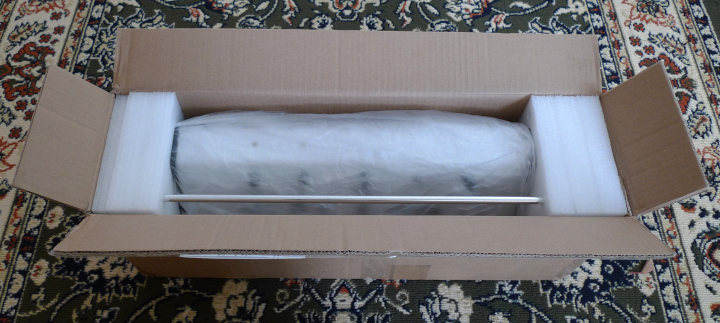
Above is pretty much how it came (IIRC) but of course with the top taped shut.
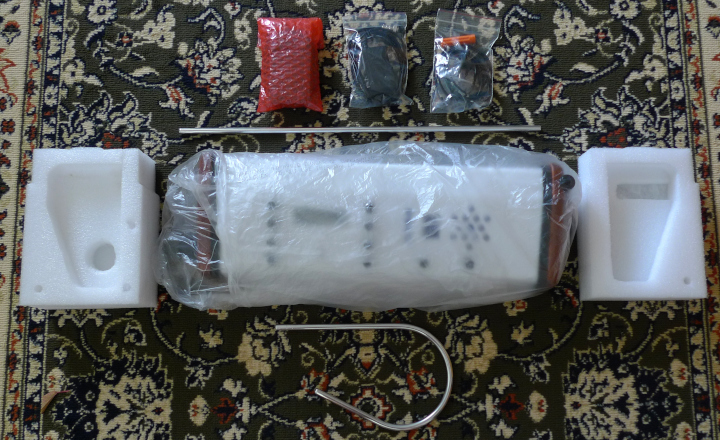
Everything (minus other packing) that was in the box. Look at those custom foam end caps! Roger must have spent nearly as much time packing it as he did building it! At top are some accessories, from left to right: footswitch, power supply, and ground wire with special banana jack AC plug mount.
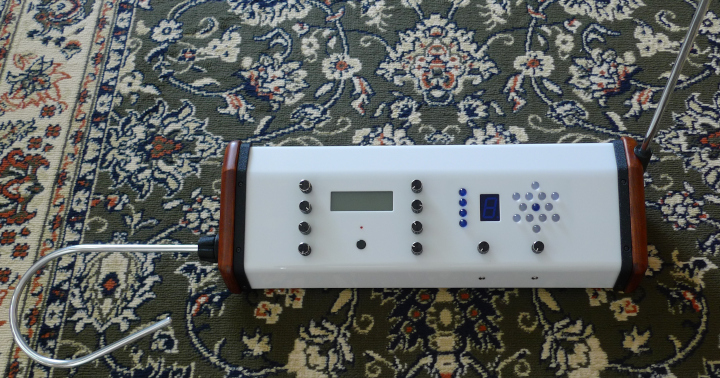
Here it is out of the plastic bag and with the antennas connected. The pitch rod slips right in, the volume rod only takes a slight tightening of the plastic nut to keep it secure.
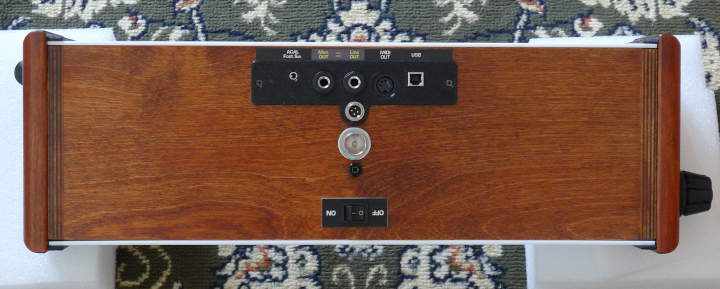
The bottom of the unit. From left to right across the top: ACAL footswitch input, Main stereo output, Line stereo output, MIDI output, USB serial port I/O. Above the central mic stand mount is a 4-pin aircraft connector for power, below it a banana jack for ground, and below that the power rocker switch (conveniently located, but not too convenient if you know what I mean).
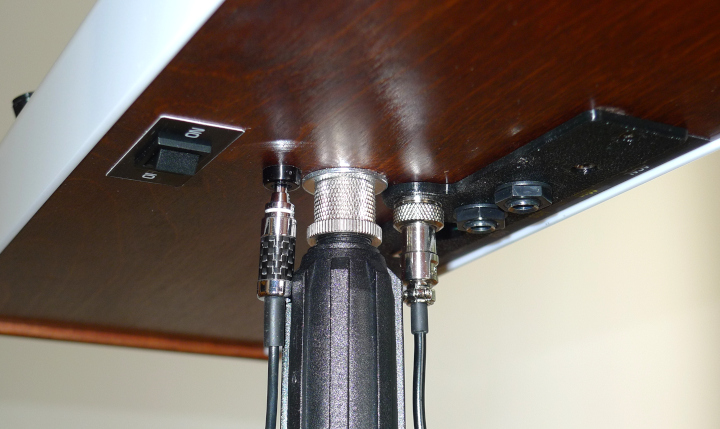
Here you can see the ground banana plug, the mic stand mount threaded in, and the power plug.
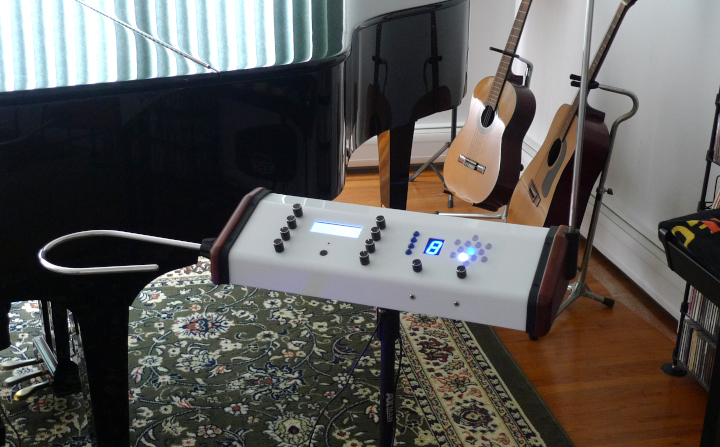
And here it is in our music room. I can't wait to show off this baby! Thanks a million Roger!
[EDIT] Maybe I should have done this outside in the grass: https://www.youtube.com/watch?v=N1zPm7UTYjs
[EDIT] Maybe I should have done this outside in the grass: https://www.youtube.com/watch?v=N1zPm7UTYjs
The D-Lev is BEAUTIFUL! The case that Roget made is also gorgeous!
I nearly died after watching the unpacking of Claravox - i can’t imagine any REAL musician treating even a very old and substandard instrument that way, let alone an allegedly top-of-the-line “professional instrument!“ Heck, the VERY FIRST THING music teachers do when introducing an instrument is how to care for it properly.
Watching the Claravox catapulting out of the box and landing on )presumably wet) grass was the most egregious abuse of a brand new instrument I believe I’ve ever seen. I wonder if the burlap face covering now has grass stains! LOL! Perhaps the video is merely a statement on the actual quality of the Claravox - were the electronics made from very old and used Radio Shack parts?! LOL!!
Anyway, enough of that! The UI of the D-Lev is displayed on your P3 in its full glory - clean and simple (the various controls become self-explanatory after a single run through with the manual). You and Roger have developed a gorgeous instrument and it’s going to be very exciting to see how musicians take to it.
You must be logged in to post a reply. Please log in or register for a new account.